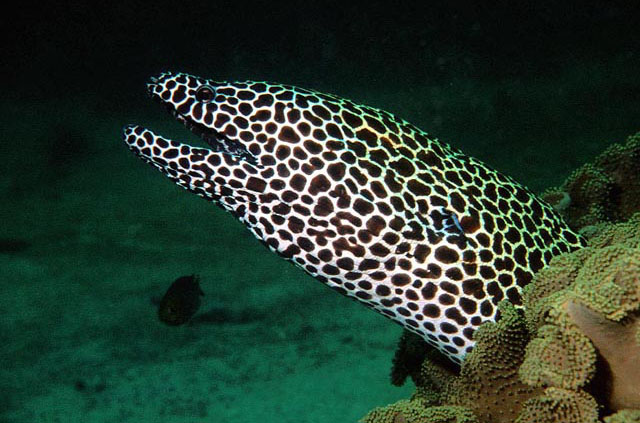| Muraenidae (Moray eels), subfamily: Muraeninae |
| 300 cm TL (male/unsexed) |
|
reef-associated; brackish; marine; depth range 1 - 50 m |
| Indo-Pacific: Red Sea (Ref. 33390) and East Africa to Papua New Guinea (Ref. 9710), north to southern Japan, south to Australia. |
|
Dorsal spines (total): 0-0; Dorsal soft rays (total): 0-0; Anal spines: 0-0; Anal soft rays: 0-0; Vertebrae: 138-144. Basically white with black blotches and interspaces forming a honeycomb pattern (Ref. 30404, 48635). Some individuals have a near black overall appearance (Ref. 48635). Blotches variable between individuals and size, often in relation to habitat - those in clear coral reefs usually have proportionally less black than those found in turbid waters (Ref. 30404).
Description: Characterized by body depth at gill opening 11-18 in TL; origin of dorsal fin well anterior to gill opening; anus anterior to middle of body; preanal length 2.1-2.2 in TL; elongate canines in single row on intermaxilla, longer than other canines at front jaw; biserial vomerine teeth in adult (Ref. 90102). |
| Inhabits reef flats and outer reef slopes of continental reefs (Ref. 9710). One of the two largest of Indo-Pacific morays. Often in holes with cleaner wrasses or shrimps (Ref. 48635). Feeds on cephalopods and small fishes (Ref. 30573). Large adults may be aggressive (Ref. 9710). Minimum depth reported taken from Ref. 30573. |
|
Least Concern (LC); Date assessed: 17 August 2011 Ref. (130435)
|
| reports of ciguatera poisoning |
Source and more info: www.fishbase.org. For personal, classroom, and other internal use only. Not for publication.

